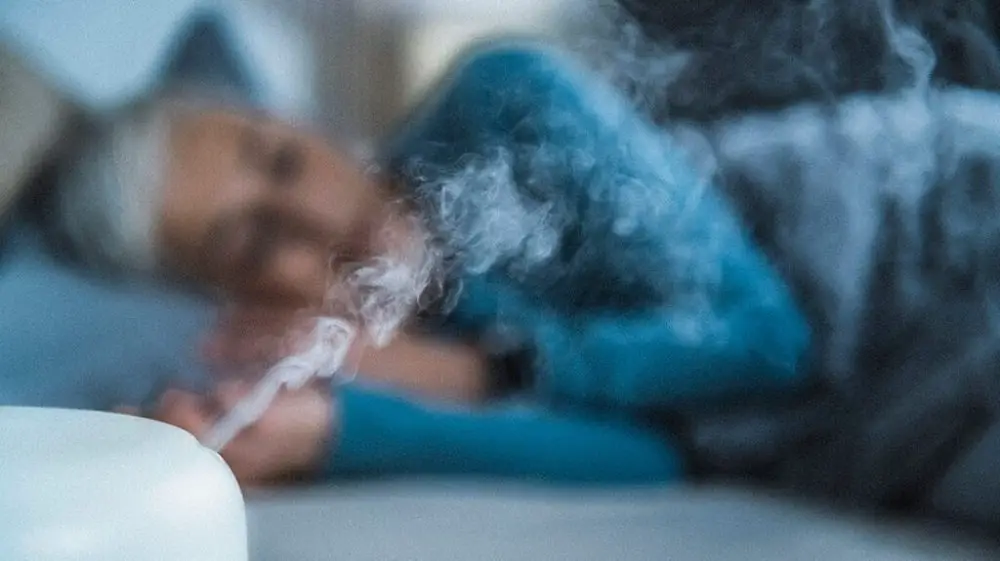When you have asthma, your body treats things in your environment as though they were a severe danger. Your airways shut down in an attempt to protect your body, making it hard to breathe. The reaction is so strong that about four thousand people die annually from asthma, so getting it under control is vital and life-saving. Fortunately, you can do a lot to help yourself or family members who have asthma. Naturally, you need to listen to your doctor, keep your rescue inhaler, and anything else they suggest, but what about a vaporizer or humidifier? Well, the truth is that you still need to ask your doctor because allergy symptoms, which can contribute to asthma, are helped by moist air. Unfortunately, dust mites, which contribute significantly to asthma, also thrive in the humid air. Your situation will depend on where you live and what triggers your asthma.
Vaporizer & Humidifier Differences
Is a vaporizer or a humidifier best for asthma? A humidifier is better for asthma than a vaporizer. Unfortunately, The Asthma Society of Canada does not recommend using either one. However, the American Academy of Allergy, Asthma, and Immunology (AAAI) recommends keeping humidity between forty and fifty percent. Ask your doctor what’s best for you.
Before you talk to your asthma care doctor about getting a humidifier or vaporizer for your symptoms, let’s discuss the differences between the two devices. Essentially, both varieties help people breathe easier indoors by adding moisture to the air. However, the methods are very different.
A vaporizer heats water to produce warm steam. Meanwhile, a humidifier adds cold mist to the air through one of several mechanisms. For example, a diffuser atomizer, which is a small humidifier, uses vibration. Other humidifiers use spinning central cores (impellers), or a wick and fan system (evaporators).
You can use these devices seasonally to help keep the air warmer or cooler. Similarly, you may want to use a cool humidifier to prevent concerns over burning if you have pets or small children. Moreover, those who use essential oils should choose options that are designed to handle oils correctly.
Always Monitor Your Humidity at Home
Before you decide to add any moisture to your home air, you need to know how much you already have. Unfortunately, humidity below thirty percent tends to lead to dry skin. Excess static is also an indicator of low humidity. Additionally, too little moisture may irritate breathing passageways and lead to nosebleeds or other issues.
Avoid nosebleeds and breathing problems with a Miroco Cool Mist Humidifier for large rooms. With six liters of water you can keep a large space at the ideal humidity level for twenty to sixty hours. See the outstanding Amazon reviews here.
On the other hand, humidity above fifty percent has it’s downsides as well. High humidity leads to dust mite overgrowth, mold and can also cause breathing problems. Furthermore, it can contribute to problems with bacterial growth. Thus, a simple, effective, and inexpensive hygrometer will help you decide when and if you need more water in your air.
Those who live in naturally dry climates, like the Sonoran Southwest, will typically find low humidity for most of the year. At the other end of the spectrum are swampy locations like most of Louisiana, which are high in moisture virtually all the time. For everyone in between, it’s more important to test the air.
Cleaning a Humidifier
When using a humidifier for asthma, or any other reason, it’s essential to clean it properly. A dirty humidifier can grow mold or bacteria. Additionally, it may help distribute allergens around the room. Doubtless, that will not help your asthma and may make it worse.
Never leave water standing in your humidifier tank. Mosquitoes breed in stagnant water, and so do other nasty things like mold. Make sure you dump and refill your tank daily with purified or demineralized water. I recommend allowing it to dry thoroughly before refilling.
Additionally, you need to clean the water reservoir every three days or more often. Some sources recommend daily cleaning. Fortunately, this takes only a few moments, and it will help with your indoor air quality and safe humidifier use.
Use a three percent hydrogen peroxide solution if possible. Alternately white vinegar or rubbing alcohol work in a pinch. However, make sure you thoroughly rinse your cleaning solution out before renewing the water or turning it on.
Finally, choose a model that uses demineralization filters. Read the directions and remember to replace these on time for your unit. A clean humidifier puts out pure moisture, but anything less is spewing all sorts of nastiness into your asthma prone lungs.
Asthma With Allergies & Dryness
If your allergies are triggering your asthma, talk to your healthcare provider about using a humidifier or vaporizer. If the allergens and not asthma is the main problem, a steam vaporizer could be the better choice. The heated moisture tends to have fewer contaminants.
Those who have notably worse problems in winter should discuss the issue with an immunologist if possible. Though not every allergy is aided by moisture in the air, many have been proven less problematic when more humidity is present.
Additionally, wintertime allergies and sinus dryness are miserable. Adding moisture could provide much-needed relief to assist your body in handling the allergens. Plus, a more comfortable breathing passage is less likely to overreact by thinking it’s under assault.
Chapped lips are another perpetual problem for sufferers. While a good lip balm or chapstick can help, raising the moisture level provides a natural solution to help you stay comfortable. Especially if you sneeze frequently, tissues can suck the moisture out of your face from repeated contact. Don’t stay miserable.
Use a Pure Enrichment® MistAire™ Silver to keep allergies and dry throat at bay. The nozzle turns a full circle to aim it where you need it most. Best of all, you’ll find it’s extremely quiet so you can leave this ingenious device on overnight. Learn more on Amazon when you click here.
Other Reasons to Consider A Humidifier
Asthma and allergies aren’t the only conditions that could benefit from your humidifier. Pediatricians often recommend them for nurseries to help babies breathe well. Colds, pneumonia, and the flu might also benefit from more humidity since it helps inflamed air passages and reduces mucous.
An ideal humidifier for any nursery or small room is the TaoTronics Cool Mist from Amazon. This one-point-eight liter compact cool humidifier is filterless. Moreover, it has auto shut off so you won’t over dampen a room. Get one delivered to your door when you order here.
Pull out your humidifier any time your hygrometer dips too low. Your sinuses, throat, and lungs will thank you. Plus, you can use a little light moisture to keep down the dry skin and shocking carpet experiences in winter. Static doesn’t get as bad in humid climates.
Humidity, Asthma & Dust Mites
Just because you can’t see dust mites, it doesn’t mean they’re not contributing to your asthma, but a humidifier or vaporizer won’t help. These microscopic insects feed on dust, which is comprised mainly of shed human skin cells. While they won’t attack a living human hos, simply breathing in their feces may trigger your asthma.
Regular exposure to dust mites and their droppings can cause chronic inflammation. While this is bad for anyone who has asthma is especially at risk when this happens. As much as sixty-four percent of asthma patients complain that dust triggers attacks. It’s probably not the organic material itself, but rather the insects inside it that are the source of the issue.
Don’t Give Dust Mites Water
Because dust mites don’t drink liquid water, they need to absorb it to survive. In damp climates, these invisible pests thrive because food and water are so plentiful. Meanwhile, in arid, desert climates, dust mites don’t make it. Moreover, there are places they cannot survive at all.
Unfortunately, using a humidifier around dust mites is encouraging them to live and breed in your home. Instead, skip the extra humidity. Or, if you cannot breathe comfortably without it, take additional steps to reduce dust mites around your home.
Ditch the Dust Mites & Save Your Humidifier
First, you need to reduce the dust-mite positive environment. Use your humidifier sparingly, and only when you genuinely need it. Beyond that, you can look at getting rid of their habitats to reduce the issue so you can use that humidifier.
Get rid of carpets and rugs. They are a fantastic home for dust mites. Anywhere you walk, sit or lay regularly, you shed a lot of skin cells, and that feeds your dust mites. Replace pillows with hypoallergenic foam to cut down on habitats for dust mites.
If possible, switch to a foam mattress or waterbed since dust mites don’t thrive inside either. Cover cloth furniture and wash your coverings regularly—vacuum and dust every two to three days to remove excess dust and dust mites as well.
When You Can’t Have A Humidifier
Some homes cannot have a humidifier. Perhaps your area is too mold-prone, or there’s someone else in the house which it bothers. Whatever the reason, you can still add some moisture to your air and breathe easier.
Sadly too many plants can trigger allergies and asthma. Luckily, not all plants are problematic. Consider adding some live greenery to your home for added moisture. Having plants around calms the mind and keeps your home a little more humid. Plus, they create fresh oxygen to help you breathe better.
Final Thoughts
Whether you, and your doctor, opt to use a humidifier, vaporizer, or both for your asthma depends on your situation. If you live somewhere, especially dry, it will help more. Meanwhile, living in a very damp environment makes them virtually useless.
Remember to use only filtered, demineralized water with humidifiers and vaporizers. Doing this will help prevent bacterial growth and mineral buildup on the inside. Regular cleaning is vital for vaporizer and humidifier users. Otherwise, you could end up inhaling mold or bacteria, which definitely won’t help your asthma.
When it comes to managing symptoms of asthma, keeping down the dust mites can make a huge difference, and unfortunately, adding moisture is counterproductive for that purpose. Still, many sufferers find they breathe a little better when the humidity is balanced in their air.

